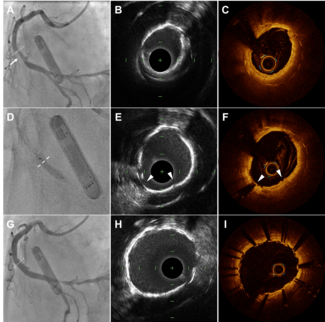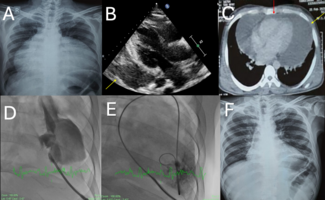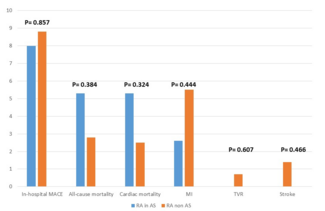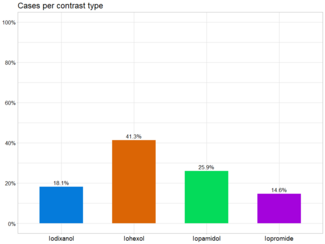Modified Transcatheter Aortic Valve Replacement: The Pros and Cons of Removing the Guidewire Immediately After Valve Deployment
© 2025 HMP Global. All Rights Reserved.
Any views and opinions expressed are those of the author(s) and/or participants and do not necessarily reflect the views, policy, or position of the Journal of Invasive Cardiology or HMP Global, their employees, and affiliates.
Abstract
The authors propose a modified transcatheter aortic valve replacement technique wherein the removal of the guidewire and delivery catheter immediately after the valve implantation helps to not only shorten the procedure but also decrease complications induced by the guidewire and delivery catheter.
Since the advent of transcatheter aortic valve replacement (TAVR), there have been rapid changes in the procedural steps. The changes are due to the development of safer, more reliable hardware, as well as protocols for preventing and managing complications. We propose a modified TAVR technique wherein the removal of the guidewire and delivery catheter immediately after the valve implantation helps to not only shorten the procedure but also decrease complications induced by the guidewire and delivery catheter.
The main focus during the TAVR procedure, both in a self-expanding (SEV) or balloon-expanding (BEV) platform, is to maintain the position of the guidewire in the left ventricle (LV). These "extra-stiff" support wires, namely, the Amplatz Super Stiff (Boston Scientific), the Safari (Boston Scientific), the Confida (Medtronic), and the Lunderquist (Cook Medical), are associated with inherent benefits and risks. The benefits include the physical rail-roading strength to assist in the delivery of bulky hardware through tortuous, calcific, angulated, and complex aortic and valvular anatomies. In addition, during the positioning of the valve with a gentle push or tug, they allow for finer adjustments without changing the lie along the greater curvature of the aorta.
The risks and complications of these guidewires include LV wall and apical perforation, chordal tethering causing mitral valvular incompetence, clot formation, and ventricular ectopy. Of these complications, nearly 30% are due to guidewire-induced perforations, necessitating emergency cardiac surgery.1 Other risks include disabling stroke, acute kidney injury, and access-site major bleeding and embolic complications as a result of increased catheter manipulation and exchange, all of which can be directly or indirectly linked to the above-mentioned guidewires, and are associated with increased morbidity, mortality, and impaired quality of life at 1 year. Therefore, it is necessary to explore procedural changes that will potentially reduce these risks and yield improved patient outcomes.2
In the present procedural steps for an SEV (Video 1), namely the Evolut series (Medtronic), the guidewire is withdrawn up to the terminal part of the nosecone of the delivery catheter to allow coaxiality, prevent cantering, and maintain a center trajectory of the deploying valve (Video 2). This also prevents inadvertent ventricular ectopics, which could hamper precise positioning. After valve deployment, the wire is repositioned in the mid-LV cavity, the delivery catheter and in-line sheath are removed, and the Sentrant sheath (Medtronic) is repositioned. Next, a pigtail catheter is placed in the LV for transvalvular gradients, which is removed on a J-wire.
Similarly, in a BEV procedure, the wire in the LV is left after the valve deployment and subsequently removed on a pigtail catheter.
Various modifications to the described procedure have been made to minimize complications, especially ones due to excessive guidewire manipulation. Nielsen et al discussed various methods of minimizing the presence of the Advantage guidewire (Terumo) in the LV while using a Sapien valve (Edwards Lifesciences).3
We propose that, after the valve is deployed satisfactorily, the delivery catheter be removed with the stiff wire, keeping it in the upper descending aorta (not the LV cavity) (Video 3). The stiff wire would then be exchanged with a Hi-Torque Supra Core (Abbott) to prevent the coil of the Safari (or another guidewire) from interacting with the distal aorta and the iliac and femoral arteries. The Perclose ProGlide would be sequentially tightened on this wire to prevent bleeding.
This "early" removal of the guidewire is done only after valve stability, anchoring, and absence of infolding have been established. Coronary patency, aortic annular integrity, and absence of evidence of annular rupture also need to be confirmed. Mild to moderate paravalvular leak is not considered as a contraindication to this early removal and thus must be checked by echocardiography after the delivery catheter and guidewire have been brought to the descending aorta.
By removing the delivery catheter early, operators can avoid re-introduction of the Sentrant sheath, which could cause atheromatous embolization or femoral, iliac, or distal aortic dissection. Most importantly, manipulation of the stiff wire in the LV, which is not visible on fluoroscopy while pushing and manipulating the Sentrant sheath in the groin with the possibility of ventricular wall or apical perforation, is prevented. This is especially important in patients with small LV cavities, thin ventricular walls, and a high aortic angle. Also, moving the stiff wire, delivery catheter, and dilatation balloons in the arch of the aorta could lead to a higher systemic embolization of atheromatous debris, causing stroke or infarction of the gut or kidneys.
Other complications that can be prevented and/or minimized by early removal are LV clot formation, the risk of which increases the longer the guidewire is in the LV, and local and systemic infection caused by excessive catheter manipulation in the groin.
The downside of removing the wire is the loss of objective measurement of the residual transvalvular gradient by a pigtail catheter in the LV and aorta. However, this is now accurately measured by echocardiography, which also checks the paravalvular leak. If the LV needs to be re-entered, the Sentrant is re-introduced over the Supra Core, which is less traumatic than the Safari guidewire. In most cases, this would be necessary for post-dilatation of the valve for a paravalvular leak.
It is widely accepted that the invasively measured gradients are more accurate than the echocardiographic ones, which are inferred from velocity measurement. Variability in echo is primarily due to variation in the left ventricular outflow tract (LVOT) diameter, cardiac output calculation, errors due to pressure recovery, and the inability to find peak Doppler gradients. Catheter-dependent variation can result from differences in "peak-to-peak" gradients, suboptimal cardiac output estimation, and inaccurate pullback or femoral artery pressure measurements, with or without transducer non-standardization.4 The catheter-based variation could be minimized by using a J-tip soft pressure wire or a pigtail catheter in the LV.
Only in selected cases where the pre-deployment post-dilatation chances are high, such as valve-in-valve, calcific bicuspid valves, and narrow LVOT, may the wire remain in the LV. A BEV will be the first choice in most of these cases, where the groin exchange of the sheath (eg, Sentrant) is not needed.
Nielsen et al proposed a technique in which the stiff wire (Advantage; Terumo) is kept in the upper descending aorta (not in the LV) and used to mount the BEV.3 The whole assembly is then tracked up to the aortic valve, which is subsequently crossed with the Advantage wire itself. This technique eliminates the need for the stiff wire in the LV in the early part of the procedure. However, this procedure is likely to be less successful for an SEV as these valves are bulkier, necessitating a longer segment of stiff wire to track across the aorta and the stenosed aortic valve.
In conclusion, unlike in the initial days of TAVR when the risk of valve embolization after an adequately confirmed implantation in 2 orthogonal views on an aortogram was nearly non-existent, we must move to decrease the other complications, which are predominantly related to the stiff guidewire.
Affiliations and Disclosures
Brig Navreet Singh, DM1; Guilherme F. Attizzani, MD2
From 1the Army Institute of Cardio-Thoracic Sciences (AICTS), Pune, India; 2University Hospitals Cleveland Medical Center, Cleveland, Ohio.
Acknowledgments: The authors thank Dr Ravi Ramani, Anene Ukaigwe, Steve Filby, and Gregory Rushings for their valuable inputs about the correctness and safety of the procedure. Their assistance in viewing the various aspects of pre-procedure planning, intra-procedure precautions, and post-procedure surveillance is appreciable and worthy of praise.
Disclosures: The authors report no financial relationships or conflicts of interest regarding the content herein.
Address for correspondence: Brig Navreet Singh, DM, Department of Cardiology, Army Institute of Cardio-Thoracic Sciences (AICTS), Golibar Maidan, Pune 411040, India. Email: navreet6626@gmail.com
References
- Eggebrecht H, Vaquerizo B, Moris C, et al; European Registry on Emergent Cardiac Surgery during TAVI (EuRECS-TAVI). Incidence and outcomes of emergent cardiac surgery during transfemoral transcatheter aortic valve implantation (TAVI): insights from the European Registry on Emergent Cardiac Surgery during TAVI (EuRECS-TAVI). Eur Heart J. 2018;39(8):676-684. doi:10.1093/eurheartj/ehx713
- Grube E, Sinning JM. The "big five" complications after transcatheter aortic valve replacement: do we still have to be afraid of them? JACC Cardiovasc Interv. 2019;12(4):370-372. doi:10.1016/j.jcin.2018.12.019
- Nielsen NE, Baranowska J, Bramlage P, Baranowski J. Minimizing the risk for left ventricular rupture during transcatheter aortic valve implantation by reducing the presence of stiff guidewires in the ventricle. Interact Cardiovasc Thorac Surg. 2019;29(3):365-370. doi:10.1093/icvts/ivz107
- Yang CS, Marshall ES, Fanari Z, et al. Discrepancies between direct catheter and echocardiography-based values in aortic stenosis. Catheter Cardiovasc Interv. 2016;87(3):488-497. doi:10.1002/ccd.26033



















